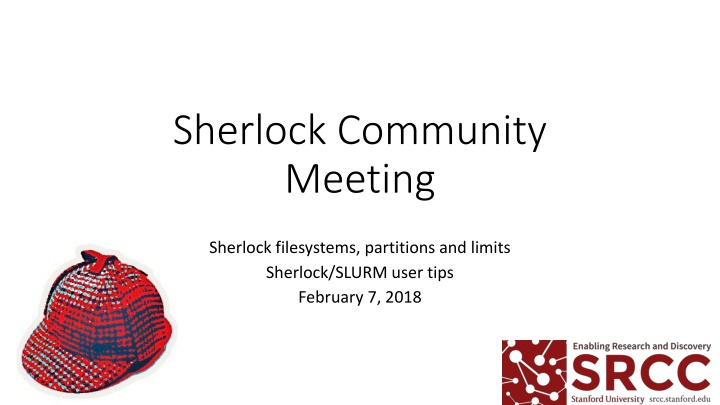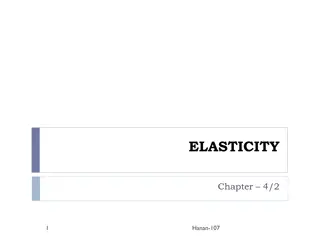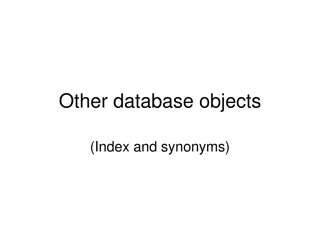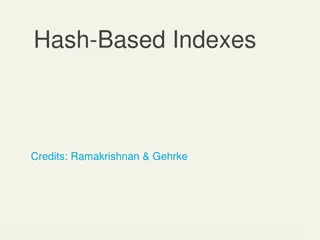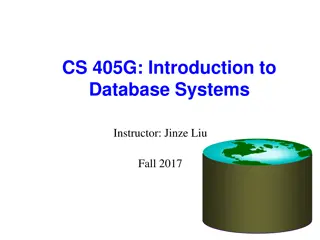Effects of New Goods on Price Indexes
Authors examine the impact of entry and exit of new products on price indices. They focus on price differentials between old and new products using monthly scanner data for food and daily products. The study highlights the biases caused by ignoring entry and suggests strategies for recognizing entry in price measurement.
Download Presentation

Please find below an Image/Link to download the presentation.
The content on the website is provided AS IS for your information and personal use only. It may not be sold, licensed, or shared on other websites without obtaining consent from the author.If you encounter any issues during the download, it is possible that the publisher has removed the file from their server.
You are allowed to download the files provided on this website for personal or commercial use, subject to the condition that they are used lawfully. All files are the property of their respective owners.
The content on the website is provided AS IS for your information and personal use only. It may not be sold, licensed, or shared on other websites without obtaining consent from the author.
E N D
Presentation Transcript
Sherlock Community Meeting Sherlock filesystems, partitions and limits Sherlock/SLURM user tips February 7, 2018
1.0 vs. 2.0 Sherlock 1.0 Sherlock 2.0 Intel Xeon v3 with 16 CPUs, 8 cores (Haswell) per node Intel Xeon v4 with 20 CPUs, 10 cores (Broadwell) per node 1U R630 server 1/2U C6320 server in a chassis 56G FDR Infiniband 100G EDR Infiniband 200G SSD and 500G Hard Disk 200G SSD 64G RAM as base server 128G RAM as base server Uses Centos 6.x Uses Centos 7.x
Sherlock Partitions normal hns gpu dev bigmem (1.5 TB - 3.0 TB) your PI s own nodes owners QOS long (--qos=long, the only QOS needed) jobs >2 days <7 days What extra partitions can I run on? scontrol show partition | egrep -B1 "AllowGroups=.*$(id -gn $user).*" | awk -F= '/PartitionName/ {print $2}'
School of Humanities and Sciences Users If your department is in H&S use hns, hns_gpu partitions in addition to normal, owners, etc. Most H&S PIs have been added. Sherlock 1- 12 nodes, 10 standard, 1 bigmem (1.5 TB) 1 GPU (8 Tesla K80s) Sherlock 2- 24 nodes, 2 large mem nodes 512 RAM, 22 standard CPU nodes (with 20 CPUs 128 GB RAM) Submit to both partitions at once if your jobs have similar requirements #SBATCH p hns,normal
Sherlock Limits: If you ever see- Batch job submission failed: Job violatesaccounting/QOS policy :( Default memory per core Max jobs running per user Default time limit per job Max runtime per job Max cores per user Max jobs in queue per user Queue name Purpose normal production interactive and/or development large memory 48 GB/core, 32 cores/node normal 2 hr 48 hrs 512 4 GB 256 3000 dev 1 hr 2 hrs 2 4 GB 2 4 bigmem 2 hr 16 hrs 32 48 GB 1 20 16 GPU/node, 16 cores/node, 16 GB/core gpu 2 hr 48 hrs 32 16 GB 16 300 queue for long- running jobs, user can use up to 16 jobs and/or 128 cores use "-- qos=long" option. long 2 hr 7 days 256 16 GB 16 64
View Sherlock Limits View the various partition limits with the sacctmgr command- sacctmgr show qos format=Name,GrpTRES,MaxTRESPerUser,MaxJobsPerUser,MaxSubmitJobs,MaxWall Name GrpTRES MaxTRESPU MaxJobsPU MaxSubmit ---------- ------------- ------------- --------- --------- ----------- normal cpu=128 dev cpu=2,mem=8G long cpu=128 cpu=32 bigmem node=1 gpu gres/gpu=4 owners cpu=2048 owner cpu=99999 MaxWall 1500 2-00:00:00 02:00:00 7-00:00:00 1-00:00:00 2-00:00:00 2-00:00:00 7-00:00:00 2 32 16 16 1 256 3000 3000
Sherlock Filesystems Home and PI home, backed up, snapshotted and replicated offsite $HOME 15 GB $PI_HOME 1 TB Fast Lustre parallel filesystem, your jobs should write/read here (6 month purge policy) $SCRATCH 20 TB $PI_SCRATCH 30 TB $LOCAL_SCRATCH 200GB even faster, but gets deleted at the end of your job http://www.sherlock.stanford.edu/docs/user-guide/storage/filesystems/
Sherlock Filesystems- Oak $OAK is an option for unlimited long term storage at $41.67 per 10TB / month (or $50 per TB / year) https://srcc.stanford.edu/oak-storage
How to ask for resources, CPUs, RAM, nodes (servers), time Only ask for what you need, your jobs will pend for less time and your Fairshare factor will be better if you do. Profile jobs in dev, run tools like sacct, htop, ps, time, python profilers 1. sdev 2. run your code on the command line, ml load python -> python mycode.py & 3. htop, top 4. Look at memory and CPU % use 5. Find the node your job is running on with squeue, then ssh to it, run htop, top, ps
Estimating resources requirements, htop [mpiercy@sherlock-ln03 login_node ~/TF]$ sbatch TF_mnist.sbatch Submitted batch job 20244339 [mpiercy@sherlock-ln03 login_node ~/TF]$ squeue -u $USER JOBID PARTITION NAME USER ST TIME NODES NODELIST(REASON) 20244339 hns_gpu TF_mnist mpiercy R 0:04 1 gpu-27-21 [mpiercy@sherlock-ln03 login_node ~/TF]$ ssh mpiercy@gpu-27-21 Can ssh to the server only of you have a job running on it. use nvidia-smi -l 1 for GPU nodes
sstat- monitor resource usage as a job runs sstat --format JobID,NTasks,nodelist,MaxRSS,MaxVMSize,AveRSS,AveVMSize 20267805 JobID NTasks Nodelist MaxRSS MaxVMSize AveRSS AveVMSize ------------ -------- -------------------- ---------- ---------- ---------- ---------- 20267805.0 1 gpu-27-21 393953K 1912732K 393017K 1912732K Compare these values to what you requested in your sbatch file or srun command
Estimate your batch jobs resource requirements Estimate your batch job s resource requirements sacct -o reqmem,maxrss,averss,elapsed,alloccpus -j 3413279 ReqMem MaxRSS AveRSS Elapsed AllocCpus ---------- ---------- ---------- --------------------- 16000Mc 1-20:54:49 4 16000Mc 4771852K 4603220K 1-20:54:49 4 The first line is the parent job You've requested 16GB per core, i.e. a total of 64 GB (4x16GB, everything in one node) Your job has used a maximum of 4771852K i.e. 4.7 GB per core You've requested more than 10 GB too much memory per core i.e. about 50 GB too much in total So, ask for less memory for this kind of jobs, e.g. --mem-per-cpu=8GB
Estimate your batch jobs resource requirements Estimate your batch job s resource requirements sacct -o reqmem,maxrss,averss,elapsed -j 20222292 ReqMem MaxRSS AveRSS Elapsed ---------- ---------- ---------- ---------- 1024Mn 00:00:10 1024Mn 579K 579K 00:00:10 1024Mn 90K 90K 00:00:10 1024Mn 524K 524K 00:00:05 reqmem = memory that you asked from SLURM. If it has type Mn, it is per node in MB, if Mc, then it is MB per core maxrss = maximum amount of memory used at any time by any process in that job. This applies directly for serial jobs. For parallel jobs you need to multiply with the number of cores (max 16 or 24 as this is reported only for that node that used the most memory) averss = the average memory used per process (or core). To get the total memory need, multiply this with number of cores elapsed = time it took to run your job
Estimate your batch jobs resource requirements Estimate your batch job s resource requirements sacct -j 6811562 --format JobID,JobName,Partition,User,AllocCPUS,NNodes,Elapsed,TotalCPU,State,MaxVMSize,MaxRSS,ReqMem JobID JobName Partition User AllocCPUS NNodes Elapsed TotalCPU State MaxVMSize MaxRSS ReqMem ------------ ---------- ---------- --------- ---------- -------- ---------- ---------- ---------- ---------- ---------- ---------- 6811562 OpenMP_ex+ normal mpiercy 12 1 00:00:02 00:00.794 COMPLETED 40Gn 6811562.bat+ batch 12 1 00:00:02 00:00.125 COMPLETED 177624K 0 40Gn 6811562.ext+ extern 12 1 00:00:03 00:00.002 COMPLETED 107904K 0 40Gn 6811562.0 hello2 12 1 00:00:00 00:00.666 COMPLETED 313156K 876K 40Gn The above shows JobID 6811562 completed successfully, using 313MB of memory, but requested 40GB/node. In this case you would reduce your memory requests for future jobs of this type to something much less - perhaps something in the range of 5-8GB. The job also took only 3 seconds, so the default time of 2 hours is more than enough.
More info http://www.sherlock.stanford.edu/docs/ Our Group- https://srcc.stanford.edu/ Questions- srcc-support@stanford.edu Slides- https://srcc.stanford.edu/sherlock-community-meeting-slides
